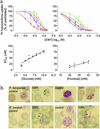Validation of the hexose transporter of Plasmodium falciparum as a novel drug target
- PMID: 12792024
- PMCID: PMC164611
- DOI: 10.1073/pnas.1330865100
Validation of the hexose transporter of Plasmodium falciparum as a novel drug target
Abstract
Chemotherapy of malaria parasites is limited by established drug resistance and lack of novel targets. Intraerythrocytic stages of Plasmodium falciparum are wholly dependent on host glucose for energy. Glucose uptake is mediated by a parasite-encoded facilitative hexose transporter (PfHT). We report that O-3 hexose derivatives inhibit uptake of glucose and fructose by PfHT when expressed in Xenopus oocytes. Selectivity of these derivatives for PfHT is confirmed by lack of inhibition of hexose transport by the major mammalian glucose and fructose transporters (Gluts) 1 and 5. A long chain O-3 hexose derivative is the most effective inhibitor of PfHT and also kills P. falciparum when it is cultured in medium containing either glucose or fructose as a carbon source. To extend our observations to the second most important human malarial pathogen, we have cloned and expressed the Plasmodium vivax orthologue of PfHT, and demonstrate inhibition of glucose uptake by the long chain O-3 hexose derivative. Furthermore, multiplication of Plasmodium berghei in a mouse model is significantly reduced by the O-3 derivative. Our robust expression system conclusively validates PfHT as a novel drug target and is an important step in the development of novel antimalarials directed against membrane transport proteins.
Figures


References
-
- Ridley, R. G. (2002) Nature 415, 686–693. - PubMed
-
- Kirk, K. (2001) Physiol. Rev. 81, 495–537. - PubMed
-
- Krishna, S., Woodrow, C. J., Burchmore, R. J., Saliba, K. J. & Kirk, K. (2000) Parasitol. Today 16, 516–521. - PubMed
-
- Krishna, S. & Woodrow, C. J. (1999) in Transport and Trafficking in the Malaria-Infected Erythrocyte, ed. Cardew, G. (Wiley, London), Vol. 226, pp. 126–144.
Publication types
MeSH terms
Substances
LinkOut - more resources
Full Text Sources
Other Literature Sources

